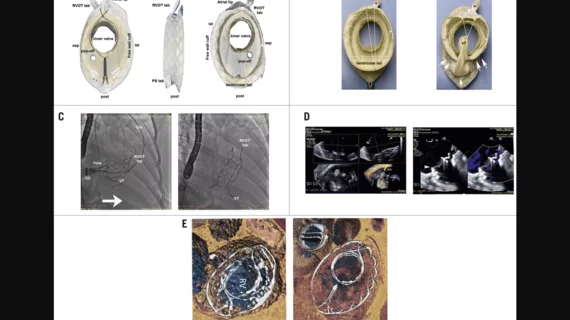Cardiologists highlight early success of new TTVR system for tricuspid regurgitation
A new-look transcatheter tricuspid valve replacement (TTVR) device may provide cardiologists with a new tool for the treatment of tricuspid regurgitation (TR), according to a new first-in-human study published in EuroIntervention.[1]
“TTVR may provide a safe means of complete relief of TR,” wrote first author Paul Sorajja, MD, a cardiologist with the Minneapolis Heart Institute Foundation, and colleagues. “Nevertheless, there are notable challenges, including the asymmetry and large size of the tricuspid annulus, potential interactions with the ventricular septum and the short distance of the tricuspid annulus to the right ventricular free wall. Consequences of these concerns include conduction disturbances, ventricular pseudoaneurysms, excessive tricuspid and right ventricular enlargement, and reduced eligibility for TTVR therapy.”
Sorajja et al. evaluated data from the first three patients treated with a new TTVR prosthesis intended to “preserve the asymmetric shape of the tricuspid annulus and right ventricle.” The VDyne Valve, designed and developed by Minnesota-based VDyne, includes 30-mm porcine trifleaflet valve that can fit any tricuspid annulus with a perimeter of up to 180 mm. The valve’s asymmetrical design includes securement mechanisms at the patient’s right ventricular outflow tract, ventricular free wall and posterior septum, an approach intended to allow small levels of oversizing.
The VDyne prosthesis is crimped or folded vertically—not radially—and its ventricular outer frame collapses by 25% during implantation, helping the operator move the proximal portion of the device over the patient’s tricuspid annulus.
“Lateral guide deflection and steering facilitate perpendicular positioning to ease placement,” the authors explained. “The total implant height post-delivery along the lateral aspect of the frame is only 15 mm. The system does not require pacing for deployment. Importantly, it is fully retrievable after full expansion and positioning, permitting assessment of its effect and stability before final decoupling.”
The first three patients treated with the VDyne valve were a 68-year-old woman, a 58-year-old woman and a 60-year-old woman. Each patient presented with a predicted surgical mortality of at least 5.2%. The implant was a success in each case, as confirmed by follow-up CT imaging after 30 days.
“These three cases demonstrate promising early feasibility,” the authors wrote. “Future studies will determine the ultimate role of the VDyne TTVR system in the management of patients with severe TR.”
Read the full analysis here.

